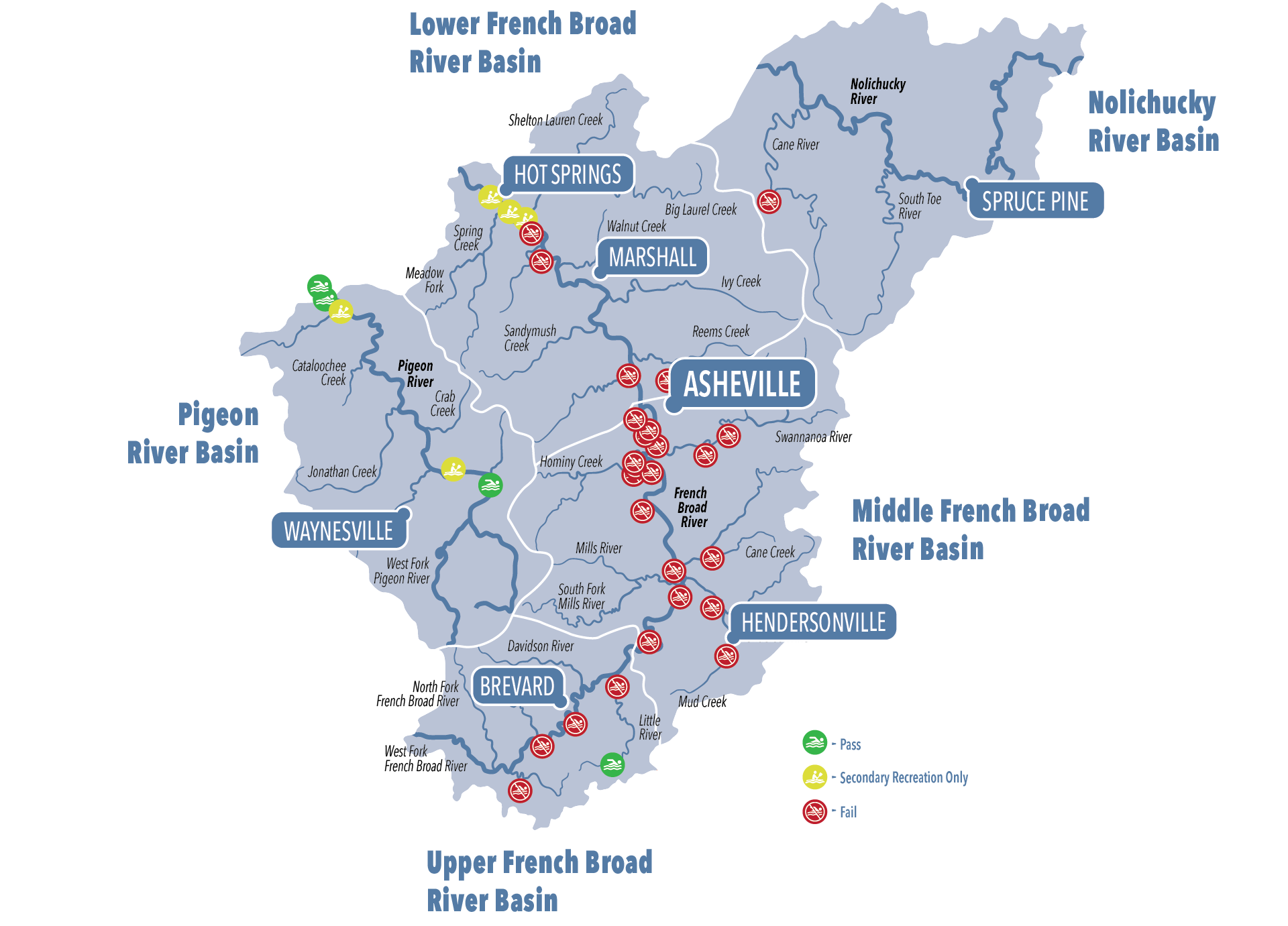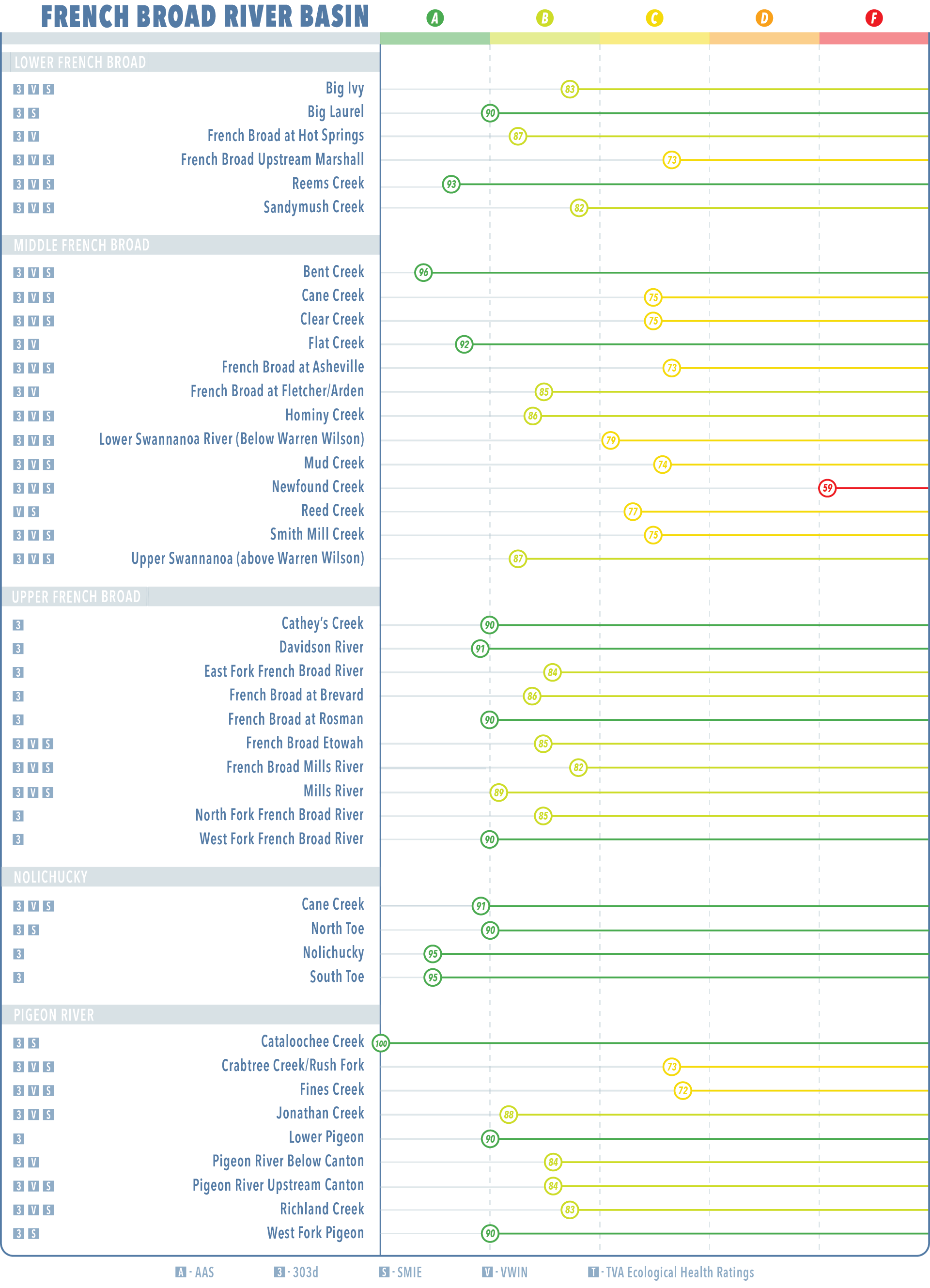State of Our French Broad River

About the French Broad River Basin
The French Broad River is one of the oldest rivers in the world, and the first trickles of the river start from the tallest peak east of the Mississippi, from the slopes of Great Smoky Mountain National Park, and off the edge of the Blue Ridge Parkway. The watershed has some of the most pristine streams and iconic sites in the Appalachian Mountains.
The Cherokee called the tributaries the Chattering Children and the French Broad River the Long Man. This description fits the tributaries that tumble off the mountains of Pisgah National Forest before snaking their way from Rosman, NC, through Asheville and into Tennessee before joining the Holston River to become the Tennessee River. European settlers named the river the French Broad because it was a wide river that flowed into French territory to the west. The Broad River was named because it flowed into British territory to the east.
From its headwaters, the French Broad flows 213 miles northwest to meet the Holston River and become the Tennessee River, just outside of Knoxville, TN.
Once called “too thick to drink, too thin to plow,” the French Broad has had its array of pollution problems over the decades. Strife with industrial, agricultural, and urban runoff, the French Broad was a cesspool of pollutants prior to the Clean Water Act in 1972. Since then, we’ve seen huge strides in its water quality.
People and industries no longer intentionally flush their wastes directly into creeks and streams, but we still regularly see poor water quality in the area. Attributed to aging infrastructure, increasing development, poor agricultural practices, and a changing climate, the French Broad is once again carrying the brunt of human impact in the region. Each time it rains, aging and inadequate sewer and septic systems leak raw sewage into nearby creeks and streams. Simultaneously, stormwater runoff brings pollutants from all the development in the area, as well as scours weak riverbanks and mismanaged construction sites, bringing in excess sediment.
An economic powerhouse, the French Broad brings in millions of dollars to the region each year. Thriving river recreation and craft breweries flank its banks. Tubers and paddle-boarders shred its waters on any given day. The river and its amenities bring hundreds of thousands of people to the area to enjoy the geography and cultural significance of the region. For these reasons, among others, it’s imperative that we continue to work to make the French Broad the best version of itself year after year.
Swim Guide E. Coli Bacteria Analysis

The French Broad River is the most impacted by bacterial contamination out of all the other rivers sampled. The Middle French Broad had an average E. coli level of 1922.8 (MPN/100mL), nearly eight times the EPA standard, across 205 sampling events. The Upper French Broad, which passes through Brevard, NC, was only marginally better, with an average E. coli concentration of 607.6 MPN/100mL. The Lower French Broad, which flows through Hot Springs, NC, was the least polluted section of the watershed; however, it still often failed the safe swimming standard and, on average, only passed the more lenient safety standard of 406 MPN/100mL for secondary recreation activities like paddling, where accidental water consumption is less likely.
The Pigeon River was the cleanest in the French Broad River Basin, with an average E. coli of 206.4 (MPN/100mL) across 69 sampling events. The French Broad River passed some of the time in the Hot Springs area. The French Broad remains heavily in the red, meaning there are regularly unsafe levels of E. coli in the river. The dirtiest sites of 2022 were in the French Broad at Hominy Creek near Bear Creek Road, Shiloh, and Hominy Creek Greenway.
Total Samples Collected: 457
Average E. coli across all sites 1110.3 MPN/100 mL
61.5% of sites sampled failed to meet EPA recreational standards
Middle French Broad: 1922.8 MPN/100 mL across 205 samples
Upper French Broad: 607.6 MPN/100 mL across 119 samples
Lower French Broad: 404.2 MPN/100 mL across 61 samples
Nolichucky: 685 MPN/100 mL across 3 samples
Pigeon: 206.5 MPN/100 mL across 69 samples
Cleanest Swim Guide Sites (Average E. coli):
- Pigeon River at Hartford - 88.1 MPN/100 mL
- Little River at Cedar Mtn. Canteen - 108.9 MPN/100 mL
- Pigeon River at Canton Rec. Park - 181.3 MPN/100 mL
Dirtiest Swim Guide Sites (Average E. coli):
- Hominy Creek near Bear Creek Rd - 6194.4 MPN/100 mL
- Shiloh - 5363.1 MPN/100 mL
- Hominy Creek Greenway - 4960.5 (MPN/100 mL)
Stream Health Analysis
The Pigeon received a Stream Health grade of Good (B). The Upper and Lower sections of the French Broad River both received grades of Good (B), but the Middle French Broad which travels through Asheville had a Stream Health Grade of Good-Fair (C) reflecting ongoing concerns about pollution and impacts of agriculture and development.
The Nolichucky received a Health Grade of Excellent (A) — indicating better water quality compared to the French Broad and Pigeon.

How We Grade
A (90-100) - Excellent
Streams with excellent water quality, low pollution levels, and healthy aquatic insect and fish populations.
B (80-89) - Good
Streams with good water quality but some impacts from pollution or development. Aquatic life and fish populations were relatively healthy.
C (70-79) - Good-Fair
Streams with average water quality. There are some concerns about pollution inputs and development impacts. Generally, aquatic life and fish populations were healthy but could become negatively impacted in the future.
D (60-69) - Fair
Streams with below-average water quality. Pollution is a concern, and aquatic life and fish populations were not as healthy as they should be.
F (<60) - Poor
Streams with poor water quality. Pollution levels were often high, and aquatic life and fish populations were impacted.
Stream Health Results by Tributary
With over 40 test sites, The French Broad River Basin achieved an overall Stream Health grade of Good (B), and most sites received grades of Good (B) or Good-Fair (C) grade.
The only testing site in our mountain region to receive a Poor (F) grade was, unsurprisingly in the French Broad Watershed. That site, Newfound Creek, had a score of 59 and is heavily impacted by long-term agricultural activities. On the other hand, Cataloochee Creek, which flows through Great Smoky Mountain National Park into the Pigeon River, had a perfect score of 100.

